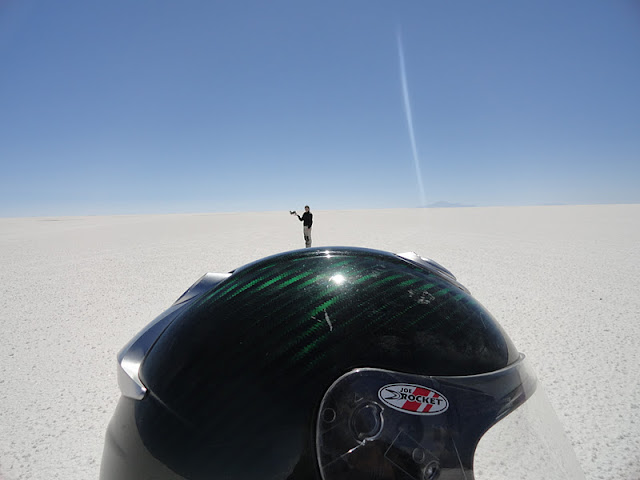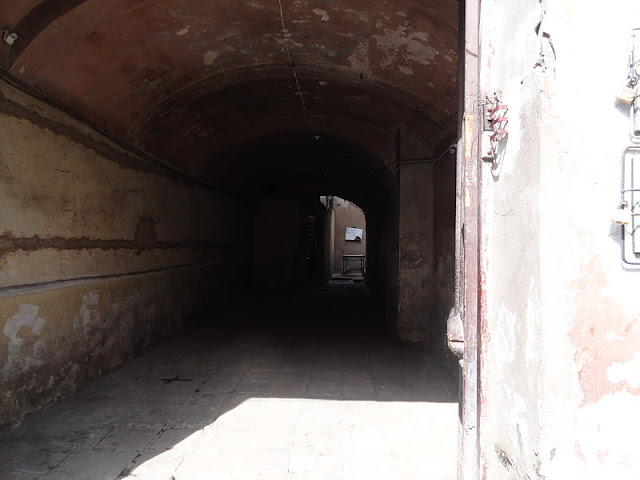
The day we left Puno for Bolivia was clear and bright, and we both felt great riding along the edge of Lake Titiacaca toward the border. The Peruvian side was about as easy as it gets, and after less than 10 minutes we were on our way to Bolivia. As U.S. citizens we have the special priviledge of paying $135 US to enter the country, while everyone else enters for free. Evo Morales, the current and socialist leaning president of Bolivia, thought it wasn't quite right that his citizens had to pay hundreds of dollars and jump through a variety of legal hoops to enter the U.S., while U.S. citizens entered his country for free. So he changed it so that we couldn't. On our budget we definitely feel $270 in surcharges, but it's hard to get too bent out of shape when you look at the facts, so we ponied up and headed in. The customs officials were out to lunch from 1:30 to 3:30, but around 3 one of the officials who had been standing around looking at us for an hour decided that we had waited long enough.
Straight away he informed me that the open gate I had ridden through and parked 10 feet after was the legal boundry of Bolivia, and passing it without customs paperwork was an "infraccion." I gritted my teeth, apologized, and sarcastically asked him if he wanted me to move it back 10 feet. Of course he didn't, he just wanted to say that and see if I handed him some cash. I didn't. After a five second, Larry David-style staredown we both said, "Ok" and took our seats to get down to business. Much to his dismay all of my paperwork was in perfect order (hey, I've done this 14 times now!) and he really had to dig to find something to hassle me about. When he looked over the title he found it; the license plate number is not listed on the title. I explained to him that in the U.S. cars change license plates every few years, and the title is permanent, so the plate number is not on the title. Absolutely true, but NOPE. Not in his world, and that's where we were playing.
Another stare down, and he defiantly declared that I couldn't enter until I produced paper that proved that plate went to that bike. (Or, it was implied, gave him some cash.) That's just not me, so I said I would be right back. I walked out to the bike, got the expired registration, ripped off the corner with the date (they got me for that in El Salvador, and the registration hasn't been out since) and took it back to him. "What was on this corner?" "Hmm, no se" (You know what? I really don't know! Now what?) There was the plate number, the VIN number, and a small missing corner on a document of a type he had never seen and would never see again. - How many times do you want to go around?! -
With hate and defeat in his eyes he entered our info and we left. Lesson: If you want some money sell something or ask for a handout, because if you try to scam me for it it's going to be a long day.
We were only eight kilometers from Copacabana, so the riding day was over in record time. Copacabana is a funny little resort town on Lake Titicaca, which appeared to cater to mostly Bolivian tourists. We found a big hotel on the beach, secured a penthouse suite with a jacuzzi...scratch that, literally the only jacuzzi in Copacabana, (for $22 a night) and headed down to check out the life on the beach.
 |
| Jill on our private balcony |
Down on the beach there was all sorts of activity, but what caught our eyes was the hourly dirtbike rental guy. Standing next to a row of oft-crashed, beaten down bikes, he would rent you a bike without even cursory formalities - hand him $10, you have a bike for an hour. Jill had been wanting to gain some experience, so we plunked down $20, checked the controls, and took of on two Yamaha 175's that looked like they had spent the last decade in a cement mixer. We parked mine and I hopped on with Jill, for a little refresher before she took her first solo motorcycle ride. After 10 minutes practicing the basics I hopped off, and coached her via helmet radio. In another 10 minutes we were riding along side by side, and Jill was dodging dogs and burning up the beach like an old pro. We haven't had a video in a while, so here you go:
Jill riding on the beach
Our hour was up faster than we would have liked, but with the storm coming in (evident in the video) it was just in time - we were being pelted by hail before we even made it back to the hotel room! The storm was short-lived, and we had a good view again by sunset.
 |
| Sun, boat shadows on the lake, and hail streaking across the balcony |
Aside from beat up dirtbikes, Copacabana is also famous for boat tours to the "Isla del Sol," the birthplace of the sun in Incan mythology. $3 gets you a round trip ride to the island, a total of five hours on a boat. Not bad! We set out at 7am, and it was about as cold and nasty as it could get. For the first hour everyone huddled inside the boat and wondered why it had an open seating area on the roof. Sick of the outboard engine fumes, I was the first to venture out onto the deck, and though it was inhospitable, at least I wasn't huffing smoke.
After not too long the morning fog was gone, an everyone was coming up to have a look at the deck.
Another hour of cruising between rocks and islands we docked at the island, and set off on a hike to the Incan ruins. The hike was nice, but four days out of Machu Picchu it was hard to be too impressed with the buildings.
 |
| Incan sacrifice table - a bad place to be a llama |
I started feeling a certain familiar...urgency when we were hiking, and made a b-line for the closest restroom - which was 45 minutes away, in town. Aaghhh!
I survived, so we hopped on the boat and made it back to Copacobana just before dark.
The next day we were on the road again, headed for La Paz. To get there we had to cross the lake, and to do that we needed to catch a ferry.
The term "ferry" applies quite loosely to these vessels, which were little more than giant wooden rafts with outboard motors on the back.
 |
| Jill and Mario, the jovial owner/operator of our $3 ferry. |
Safely on the other side, we headed straight to and through La Paz, where we didn't take a single picture, but only because we didn't see a single thing we wanted a picture of. Oh well, on to the Amazon!
























































